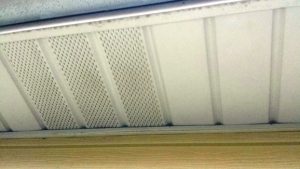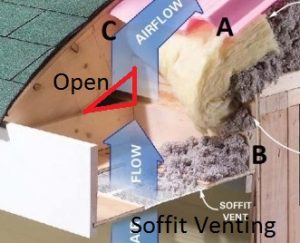 I am air-sealing & insulating my attic trying to help prevent ice dams which included adding baffles in each bay. Well while looking outside I see that I only have one vented panel every 4′. Do I need to change out / use ventilated soffits outside only? Hmm, how about the eaves, would it hurt to use ventilated panels or…
I am air-sealing & insulating my attic trying to help prevent ice dams which included adding baffles in each bay. Well while looking outside I see that I only have one vented panel every 4′. Do I need to change out / use ventilated soffits outside only? Hmm, how about the eaves, would it hurt to use ventilated panels or…
Why Ventilated Panels?
The first question is why do we need ventilated panels – the short answer is because it is needed to allow “needed” air into the attic space. The only times this is not necessary is if you are just using gable vents or utilizing a hot roof system only.
Wait, does this mean that there are area’s that don’t need them, I shouldn’t use them? Nope not necessarily; and in fact like we pointed out in “Are “Vented” Cantilevers Bad?” this will generally allow any moisture that managed to get in this area to drain out.
Now what happens if you have a bunch of vines, brush or other “green” items in this area (or maybe even an errant sprinkler system)? The short answer is that you probably should avoid using them in these areas due to the moisture that would make its way into the attic. With that the better answer is to fix the source of the moisture problem.
Do I need the entire area to be ventilated?
 In short the answer is no for most houses as shown in this picture; you see that open space – well that allows air to flow from one bay to another. Now if those rafter tails are blocked off or you used I-Joists, then the answer is that yes you need soffit venting in each bay.
In short the answer is no for most houses as shown in this picture; you see that open space – well that allows air to flow from one bay to another. Now if those rafter tails are blocked off or you used I-Joists, then the answer is that yes you need soffit venting in each bay.
How much do I need?
The long answer on this varies based on a simple formula – you need 1 SF for every 150 which is to be split equally from the ridge to the soffit. For a typical gable style roof you can then divide that answer in two and you have the “net free area” of ventilation required per side. With this answer & knowing what the net free answer is from the manufacturer you know how often you should be using a “ventilated” panel. Now that is assuming you don’t have any issues shown above, etc… In short you will want one ventilated panel for every 2 solid panels if using vinyl soffit. For vents like those shown above – one every 3 bays should be more than adequate.
Can I install more / what happens if I don’t install enough?
The first part of this ties in with the question above on areas related to soffits & cantilevers – sure you can install more and in most cases it won’t hurt. Got a powered roof vent (which you shouldn’t except in very rare conditions), well you might want to install more which leads us to…
Now on the flip side, not installing enough can cause issues. As we know air like water seeks the path of least resistance and if it can’t pull enough from outside it will pull it from your house. Trying to avoid ice dams or condensation, well that isn’t the best way of accomplishing that.
Can I vent my bath exhaust out of the soffit?
I just love questions that start off with the word can… sure you can but that is not a good idea. It is better to vent them out a gable end or through the roof. For more see our piece on Bathroom Venting.
How about intakes / exhaust for an ERV/HRV?
Intakes is a good call but for exhausts the issue regarding the bathrooms above still rears it’s ugly head – it would be better to redirect that elsewhere than where it can flow back into the attic area.
Are there any other options if soffit venting is not an option?
Besides going with gable only, there are some specialty options for those with no to very small eaves, etc… There are now numerous products like Smart Vent, Fascia Vent, etc… which generally uses a cutout to introduce air above the insulation in the attic. Just like traditional venting, you have to make sure that the vent areas remain clear and insulation should not be in direct contact with the roof sheathing.

Should I stick insulation between my outer brick veneer wall and the inner cement block wall while insulating my attic? I am adding soffit vent so i end up plugging that opening but I am concerned it will trap things between the walls. What is the right approach?
Hmmm location? With that & in general, no you should not shove insulation between the two. You want to make sure that any moisture that gets between the walls can get out & is not trapped where it can wick between the two
thank you for your feedback. i was thinking the same thing but it is nice to hear second opinion
I am retrofitting an attic that was not vented correctly and i live in a Wildland Urban Interface area. There are presently no ridge vents on the roof. Soffits under the eaves and two gable vents which are plastic with no screens. I want a balanced system with the latest approved materials for WUI. Do the gable vent negate the need of roof vents. Should I close the gables and install a ridge vent?? Where can youf ind a ridge vent that is not made out of plastic that meets WUI code.
Branguard & Vulcan are two that spring to mind for gable, soffit, & ridge
Gable vents can & do work just like the others assuming everything else was done properly – but if you do have working soffit vents, I would probably opt for sealing up the gable & going ridge in most cases. One thing to watch out for is the net free area as that varies based on product – most fire rated ones as I recall are slightly less than others meaning you need larger or more of…
I just bought this house. Attic space is 1,236 SF. I have ridge vents that equal 360 S inches. That is using 1 inch on both sides of the ridge board. I had no soffit vents so I have been adding them. I have clear shots from these up to the ridge. I have added 320 S inch of soffit vents so far. So using the FHA guildlines. 1:300 I am good with what i have, If I go with 1:150 I am well under.
The attic on a hot day gets to about 120-130 degrees with very little air flow using a smoke test. The average summer temps are about 84 Degrees. I am in a moderate wind area with a clear shot to the west. What else can I do to get the temperature down so I can use the area for storage? Thanks…
Plant trees… In all seriousness you will rarely have enough ventilation to keep things cool with the sun beating on the roof as the shingles easily will reach that temp or more & it only has one place to go – in.
Granted you could do a radiant barrier https://thehtrc.com/2012/building-science-radiant-barriers BUT attics are not really meant for storage.
The real purpose of venting is to expel limited amounts of excess heat during the winter months, & moisture year round. It can also help keep the shingles a little cooler (see hot roof article linked above) but not that much. The insulation is really meant to help keep that heat during summer from getting inside the conditioned area as quickly which gets shortcutted by people piling junk in there.
Now if you want to do storage while keeping the house cooler – you can do a combo radiant AND an insulated storage platform like we wrote about here: https://thehtrc.com/2011/air-sealing-attic-walkways-storage
Hope this helps
Thanks for the reply. I’ve read the articles and others and would like your thoughts on this. I have read this: “Without baffles (blinders that prevent outside air from crossing over the vent), a ridge vent may create almost no ventilation at all.” My ridge vent runs roughly north to south with prevailing moderate winds blowing across the vent. it is very narrow (maybe 3″ total slot) and is split between a chimney. The vent is very accessible. My thought is if during the summer months, I block off the ridge vent and us an Attic fan (understanding the cost and maintenance and my attic is sealed) and in the other months block off the fan and open the ridge vent again? Thanks.. ( Trees are not an option unfortunately)
Why block the ridge – if you want to run an attic fan, do both. Besides I would rather pull air in from the ridge than from the house itself which is where the hotest air is near. https://thehtrc.com/2011/rip-solar-powered-attic-ventilators
No real reason to block off the fan either even when not in use, it shouldn’t affect anything (whole house fan – yes / attic – no)